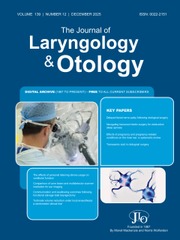No CrossRef data available.
Article contents
A case series of interventions and outcomes in patients with laryngeal squamous cell cancer
Published online by Cambridge University Press: 25 April 2024
Abstract
The larynx is the second most prevalent subsite for head and neck cancer. Over half of head and neck cancer patients present with advanced disease. We report our regional practices for palliative intent laryngeal squamous cell cancer (SCC).
Retrospective analysis of patients with laryngeal SCC treated with palliative intent, discussed at the regional head and neck multidisciplinary team meeting from July 2010 to June 2016.
A total of 65 patients were included, of whom 45 per cent had potentially curable disease but were not fit for curative treatment. Nine patients (14 per cent) underwent tracheostomy, with mean survival and hospital stay of 278 and 48 days, respectively. Four patients (6 per cent) underwent debulking surgery with mean survival and hospital stay of 214 and 1 days, respectively.
All palliative treatment measures offered to patients can have an impact on survival and quality of life. Patients should be at the centre of the decision-making process and counselled on the potential impact of interventions.
- Type
- Main Article
- Information
- Copyright
- Copyright © The Author(s), 2024. Published by Cambridge University Press on behalf of J.L.O. (1984) LIMITED
Footnotes
Alison Lim takes responsibility for the integrity of the content of the paper


